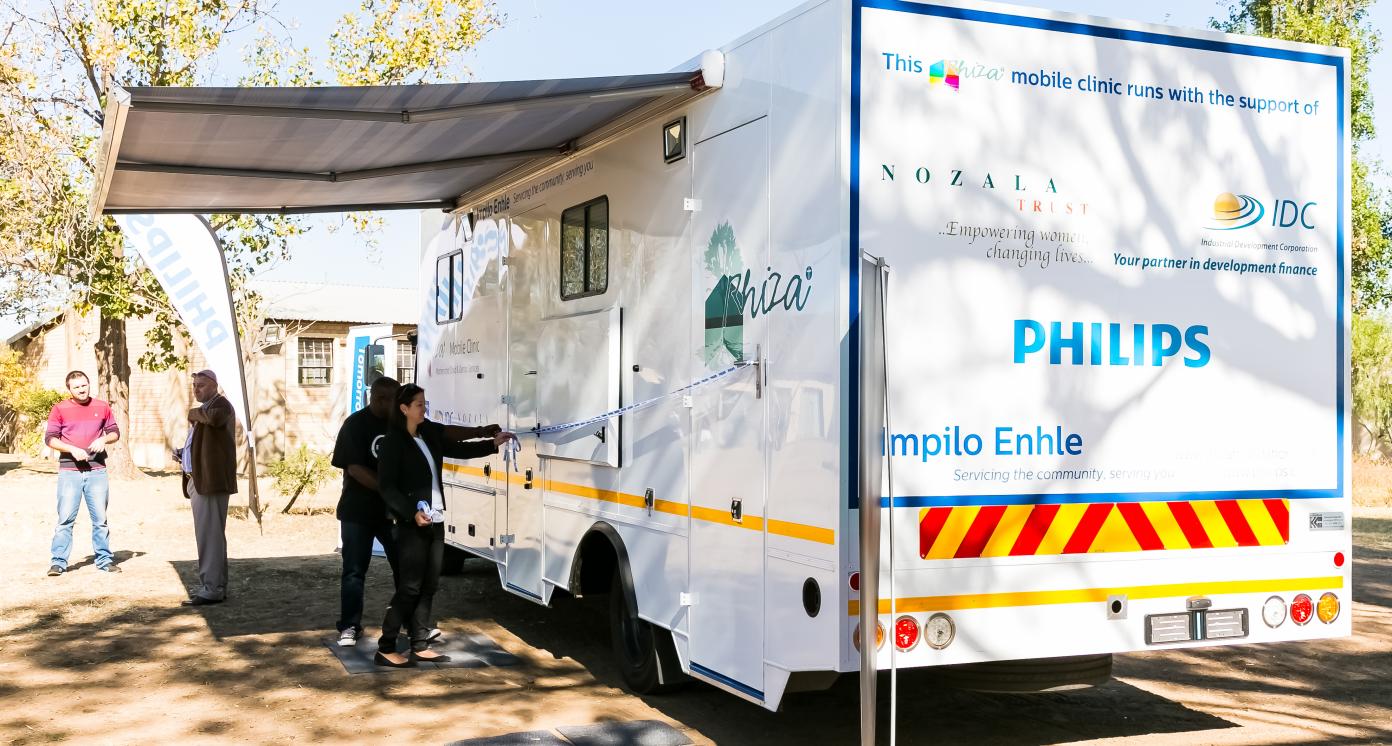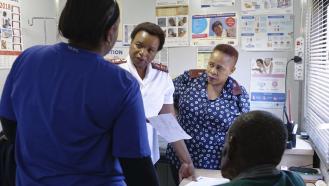Modular medical facilities




Business Model Description
Establish modular health care infrastructure solutions that can be deployed in underserved regions, such as remote rural areas.
Expected Impact
Improve access to healthcare and alleviate the pressure on existing and inefficient supply chains.
How is this information gathered?
Investment opportunities with potential to contribute to sustainable development are based on country-level SDG Investor Maps.
Disclaimer
UNDP, the Private Finance for the SDGs, and their affiliates (collectively “UNDP”) do not seek or solicit investment for programmes, projects, or opportunities described on this site (collectively “Programmes”) or any other Programmes, and nothing on this page should constitute a solicitation for investment. The actors listed on this site are not partners of UNDP, and their inclusion should not be construed as an endorsement or recommendation by UNDP for any relationship or investment.
The descriptions on this page are provided for informational purposes only. Only companies and enterprises that appear under the case study tab have been validated and vetted through UNDP programmes such as the Growth Stage Impact Ventures (GSIV), Business Call to Action (BCtA), or through other UN agencies. Even then, under no circumstances should their appearance on this website be construed as an endorsement for any relationship or investment. UNDP assumes no liability for investment losses directly or indirectly resulting from recommendations made, implied, or inferred by its research. Likewise, UNDP assumes no claim to investment gains directly or indirectly resulting from trading profits, investment management, or advisory fees obtained by following investment recommendations made, implied, or inferred by its research.
Investment involves risk, and all investments should be made with the supervision of a professional investment manager or advisor. The materials on the website are not an offer to sell or a solicitation of an offer to buy any investment, security, or commodity, nor shall any security be offered or sold to any person, in any jurisdiction in which such offer would be unlawful under the securities laws of such jurisdiction.
Case Studies
Country & Regions
- South Africa: Eastern Cape
- South Africa: KwaZulu-Natal
- South Africa: Limpopo
- South Africa: Mpumalanga
Sector Classification
Health Care
Development need
South Africa has made notable progress on multiple aspects of SDG 3 - Good Health and Wellbeing, but major challenges still remain to achieve the goal by 2030.(2)
Policy priority
The National Development Plan (NDP) aims to achieve healthcare so everyone has access to an equal standard of care regardless of income.(4) The government has committed to increasing health expenditure.(3) The NDP also outlines a national health insurance system that ensures all citizens have access essential healthcare, improves the quality of public healthcare and lowers the relative cost of private healthcare.(3) Other key areas include recruiting more professionals in the public and private sectors, improving healthcare systems and providing HIV/AIDS healthcare.
Gender inequalities and marginalization issues
COVID-19 lockdowns and restricted access to health services have directly affect women's health, particularly maternal health, unintended pregnancies, and women with chronic illnesses especially HIV/AIDS.(27)
Investment opportunities introduction
Despite progress towards achieving SDG 3, there is a significant need for private sector investment to achieve equitable access to healthcare in South Africa. This need has been illuminated by COVID-19.
Key bottlenecks introduction
Progress is still overshadowed by the inequities caused by the previous regime. Universal health coverage, value for money and funding requirements remain significant challenges.(3)
Health Care Providers
Development need
There is a very high degree of inequality in the South African healthcare sector, where 16% of the population access private healthcare and 84% are served by the public sector.(1) By 2030, the health system should provide quality care for all, but the public health system cannot meet demand.(2)
Gender inequalities and marginalization issues
COVID-19 has disrupted access to healthcare for contraception and maternal care, routine programs (HIV, tuberculosis) and sanitary dignity programs for teenage girls. Constraints in medicine supply and immunization services disproportionately affect women.(27)
Investment opportunities introduction
There is a large market for mid-fee health in other countries and the opportunity in South Africa is evident.(3) Implementing National Health Insurance should ensure rapid growth in this space.(3)
Key bottlenecks introduction
Prohibitive costs have made private healthcare too expensive for most South Africans.(2)
Health Care Distributors
Pipeline Opportunity
Modular medical facilities
Establish modular health care infrastructure solutions that can be deployed in underserved regions, such as remote rural areas.
Business Case
Market Size and Environment
84% of South Africans are uninsured.
84% of South Africans are uninsured.(20) The target income level is the bottom 20%.(17)
20% of the low income, uninsured population live an hour or more from the nearest hospital.(20)
A low cost model may be appropriate to deliver a range of health services to those uninsured (84% of the population).(20)
Indicative Return
15% - 20%
An annual return of between 12% and 16 is expected, based on a benchmark project.(26)
Investment Timeframe
Long Term (10+ years)
The expected timeframe is 5 to 15 years. Input costs (electricity) are critical in improving profitability and shortening investment timelines.(26)
Ticket Size
USD 1 million - USD 10 million
Market Risks & Scale Obstacles
Market - Highly Regulated
Capital - Requires Subsidy
Market - High Level of Competition
Impact Case
Sustainable Development Need
With large public hospitals concentrated in metropolitan areas, rural populations rely on sparsely distributed clinics and communal health centres.(10) Households within 30 minutes of a clinic are 10 times more likely to use a clinic than households having to travel for 90-120 minutes.(10)
There are considerable differences in households’ proximity to a health facility between rural and urban areas, across provinces and between socio-economic groups. Existing resources aren’t placed where they are desperately needed.(9)
Gender & Marginalisation
66% of women classified as a ‘maternal near-miss’ encounter some form of delay before receiving the appropriate level of care.(9)
Expected Development Outcome
Modular prefabricated solutions are cheaper to build than traditional infrastructure. They can also be added to existing structures where needed (e.g. extend limited storage space or add previously non-existent facilities such as surgical units).(11)
Benefits include: increased cost-effective access to healthcare in both urban and rural settings (11); reduced costs (11); improved access to primary healthcare to rural areas (17); job creation.
Gender & Marginalisation
Women have improved access to healthcare, particularly prenatal care. Women are empowered to be entrepreneurs and grow.(15) Modular health facilities are typically operated by nurses, most of whom are women (as in the case of Unjani clinics).(16)
Primary SDGs addressed

3.8.1 Coverage of essential health services
1,600 new clinics were built as part of the Reconstruction and Development Programme. The Bill on National Health Insurance (NHI) outlines the phased implementation of NHI in South Africa to achieve universal health coverage.(1)
The National Health Insurance Bill will give effect to the National Development Plan (NDP), which seeks to provide for universal quality healthcare services to all South Africans, irrespective of socio-economic background.(3)
Secondary SDGs addressed



Directly impacted stakeholders
People
Indirectly impacted stakeholders
Public sector
Outcome Risks
The range of services available may be limited due to operating staff skill level (typically nurses). This issue may be partially addressed by e-consultation solutions.(16)
The sustainability of facilities will depend on attaining a minimum threshold of regular clients (i.e. be accessible to enough people). As a result, most remote areas may remain underserved, thus reinforcing inequalities.
Impact Risks
Unexpected impact risk if modular basic health facilities stifle government willingness to address investment needs in public health facilities
Impact Classification
What
Modular prefabricated healthcare solutions that improve access to primary healthcare to rural areas
Who
South Africans who are situated far from clinics or hospitals
Risk
Low risk
Impact Thesis
Improve access to healthcare and alleviate the pressure on existing and inefficient supply chains.
Enabling Environment
Policy Environment
The South African government has a constitutional mandate to provide quality healthcare services to its citizens.(22)
White Paper on National Health Insurance (NHI): This paper outlines the South African government’s strategy for achieving universal health coverage over the next 14 years.(21) It aims to improve quality, coverage and equity, as a response to the poor performance of South Africa’s healthcare system.
Financial Environment
Financial incentives: Donors are the primary funding source for modular medical clinics in South Africa (e.g. Unjani and Owethu clinics).(17),(18),(19) Both corporates and non-government organizations provide financial support for mobile health clinics.(25) Funding is also available from the National Department of Health and provincial health departments.(24)
Fiscal incentives include: Jobs Fund Social Impact Award; M&G Investing in the Future Health Award; M&G Drivers of Change Business Award.
Regulatory Environment
National Health Act, 61 of 2003: This Act sets the legislative mandate of the Department of Health, replacing the Health Act of 1977.
Marketplace Participants
Private Sector
Owethu clinics, Unjani clinics, Witkoppen Health and Welfare Centre, Guardian Newspaper
Government
Department of Health
Non-Profit
Cipla Foundation, Johnson & Johnson Global Citizen Trust and Johnson & Johnson Family of Businesses, South African Trust, Centre for Health Market Innovations
Target Locations
South Africa: Eastern Cape
South Africa: KwaZulu-Natal
South Africa: Limpopo
South Africa: Mpumalanga
References
- (1) Statistics South Africa (2019). Sustainable Development Goals: Country Report 2019 - South Africa. http://www.statssa.gov.za/MDG/SDGs_Country_Report_2019_South_Africa.pdf
- (2) Sachs, J., Schmidt-Traub, G., Kroll, C., Lafortune, G., Fuller, G. and Woelm, F. (2020). The Sustainable Development Goals and Covid-19. Sustainable Development Report. Cambridge University Press. https://dashboards.sdgindex.org/#/ZAF
- (3) South African Government (2019). South Africa Voluntary National Review: Empowering people and ensuring inclusiveness and equality. https://sustainabledevelopment.un.org/content/documents/23402RSA_Voluntary_National_Review_Report___The_Final_24_July_2019.pdf
- (4) National Planning Commission (2011). National Development Plan 2030; Our future - make it work. https://www.gov.za/sites/default/files/gcis_document/201409/ndp-2030-our-future-make-it-workr.pdf
- (5) Africa Health (2020). Industry Insights: South Africa Healthcare Market Overview. https://www.africahealthexhibition.com/content/dam/Informa/africahealthexhibition/en/2020/pdf/AFH19_Industry_Insights-SA_MARKET_REPORT.pdf
- (6) Mapham, W. (2020). Interview with UCT GSB Bertha Centre for Social Innovation and Entrepreneurship.
- (7) Businesstech (2016).The astonishing number of South Africans who do not have medical aid. https://businesstech.co.za/news/lifestyle/129166/the-shocking-number-of-south-africans-who-do-not-have-medical-aid/
- (8) Allafrica (2020). South Africa: Pay Black Women Healthcare Workers, The Backbone of Our Health Sector. https://allafrica.com/stories/202007020672.html#:~:text=In%20South%20Africa%2C%20women%20make,by%2072%2C000%20community%20care%20workers
- (9) International Federation of Gynaecology and Obstetrics (2019). Think Equal: women's health, South Africa. https://www.figo.org/news/think-equal-womens-health-south-africa
- (10) McIntyre, D. and Ataguba, J. (2017). Access to quality health care in South Africa: Is the health sector contributing to addressing the inequality challenge? Health Economics Unit, University of Cape Town. https://www.parliament.gov.za/storage/app/media/Pages/2017/october/High_Level_Panel/Commissioned_reports_for_triple_challenges_of_poverty_unemployment_and_inequality/Diagnostic_Report_on_Access_to_Quality_Healthcare.pdf
- (11) Resolve (2018). Africa Needs Modular Healthcare Infrastructure Solutions. https://resolvesp.com/africa-needs-modular-healthcare-infrastructure-solutions/
- (12) Interview with Peter Benjamin, HealthEnabled, 21 July 2020.
- (13) National Planning Commission (2011). National Development Plan - Vision for 2030. https://www.gov.za/sites/default/files/gcis_document/201409/devplan2.pdf
- (14) Resolve (2020). Modular Infrastructure Solutions. https://resolvesp.com/modular-infrastructure-solutions/
- (15) Interview with Debbie Rogers and Chiara Kunnie, Praekelt, 24 July 2020.
- (16) Unjani Clinic (2020). Unjani Clinic. http://www.unjaniclinic.co.za/
- (17) Health Market Innovations (2020). Owethu clinic. https://healthmarketinnovations.org/program/owethu-clinics
- (18) Sutherland, M. and Krige, L. (2017). 'Unjani “clinics in a container”: social franchising in South Africa', Emerging Markets Case Studies Collection, 7(1): 23. https://www.researchgate.net/publication/312646650_Unjani_clinics_in_a_container_social_franchising_in_South_Africa
- (19) SANGONet (2019). Mobile Clinics provide Healthcare to Townships. http://www.ngopulse.org/press-release/mobile-clinics-provide-healthcare-townships
- (20) Health-E News (2015). White paper: National Health Insurance for South Africa. 2015. http://www.health-e.org.za/2015%EF%BF%BD/%EF%BF%BD12/14/white-paper-national-health-insurance-for-south-africa/
- (21) South African Human Rights Commission. The right to Healthcare. https://www.sahrc.org.za/home/21/files/Reports/4th_esr_chap_4.pdf
- (22) RH Bophelo (2017). A glimpse into the South African healthcare industry. https://www.rhbophelo.co.za/understand-the-south-african-healthcare-industry/
- (23) Department of Health (2014). Strategic Plan. Government of South Africa. https://health-e.org.za/wp-content/uploads/2014/08/SA-DoH-Strategic-Plan-2014-to-2019.pdf
- (24) Western Cape Government (2020). New and Upgraded Health Facilities. https://www.westerncape.gov.za/general-publication/new-and-upgraded-health-facilities
- (25) Cipla Foundation (2015). R3 million Owethu clinic to benefit Cottonlands KZN community. https://www.cipla.co.za/cipla-news/owethu-clinic-opens-in-kzn/
- (26) Interview with Lynda Toussaint, Unjani Clinics, 18 December 2020.
- (27) United Nations Development Programme (2020). South Africa Report 2020: Covid-19 Rapid Emergency Needs Assessment for the Most Vulnerable Groups. https://www.za.undp.org/content/south_africa/en/home/library/rapid-emergency-needs-assessment.html
















